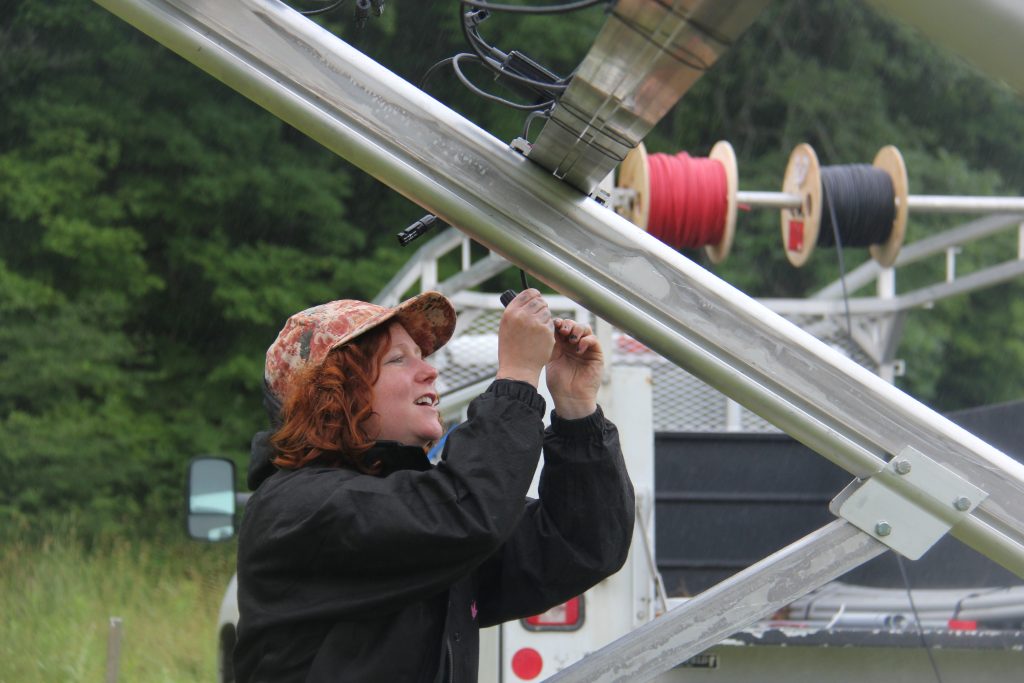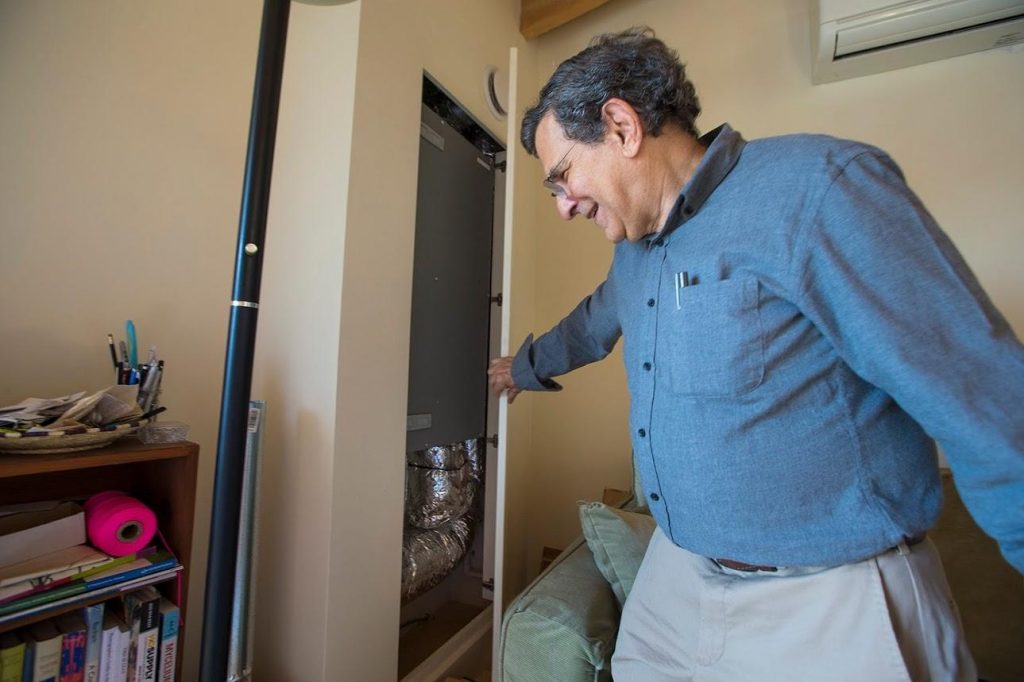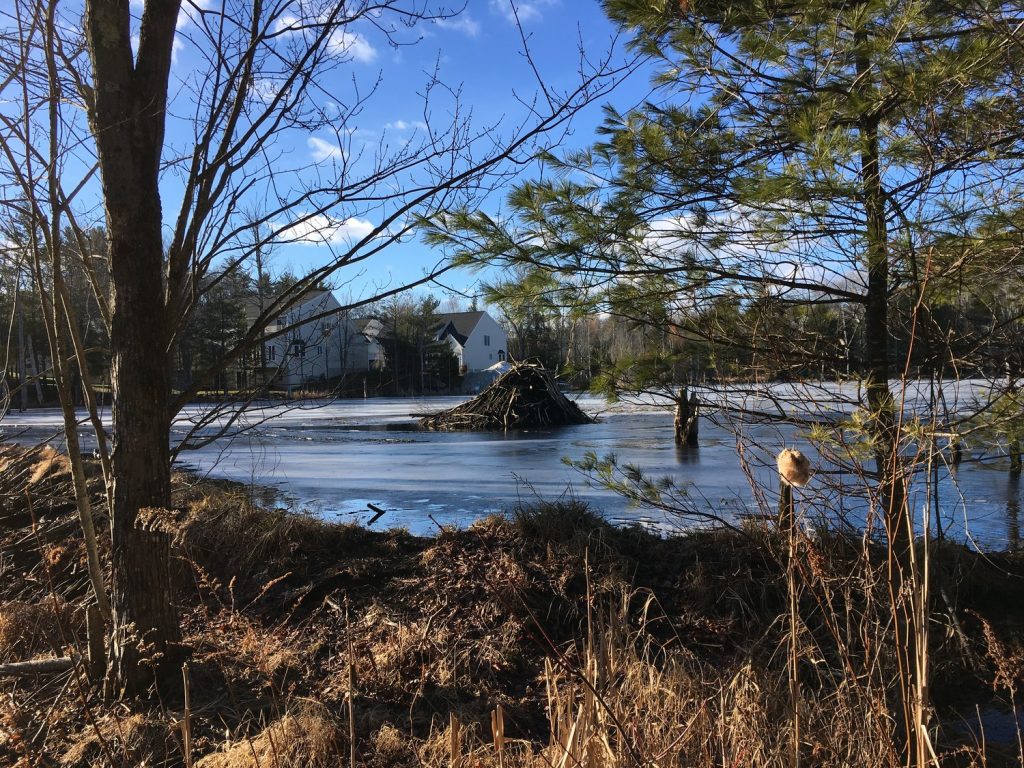Episode 51: Not In My Backyard

New England has been waiting for years for real, high speed rail to get travelers more quickly from New York to Boston, but the path of that new line caused big headaches in some small towns. Federal railroad officials have now backed off part of a new high speed rail plan — listen for our update. And it may be easier to keep a railroad from intruding on your property than a more dogged adversary: beavers. Plus, we visit an ultra-low energy use apartment building that’s so well insulated you can turn off your heat in February — in Maine.
Train Delays

The John Sill House in Old Lyme was built in the early 1800s. Advocates rallied against plans for a rail bypass that would go through the historic section of the town. One of the early plans included a bridge that would fly over the house. Photo by Ryan Caron King for NENC
The Federal Railroad Administration says it’s moving forward with a plan to bring high speed rail to the Northeast. That would shorten travel from Boston to New York City by 45 minutes. But to reach those time savings, the FRA proposed building a controversial new track that would have cut across historic landmarks and protected lands between New Haven, Connecticut and Providence, Rhode Island.
Last week, the FRA released a decision that removed that stretch from the plans. WSHU’s Cassandra Basler joins us to talk about the decision, and what it means for the future of high speed rail in New England.
To learn more about the public pushback against the FRA plan in Connecticut and Rhode Island, check out Episode 41.

The FRA plan forestalls any decision on a revised rail route from New Haven to Providence, and it calls for further study. Image courtesy FRA
Building More, to Burn Less
New England is at a time of big change in the way we get our energy. Aggressive goals to cut carbon emissions have meant a move toward more renewable sources of power. But the shift from burning fossil fuels to harvesting sun and wind power comes with challenges in a region where it’s not always easy to find space for big energy projects. The New England News Collaborative is covering these changes in a project we call The Big Switch.

Randolph-based Catamount Solar is installing an 8.7 kilowatt system in a homeowner’s yard in East Montpelier, Vermont. Kestrel Marcel is connecting the optimizers, which are a converter technology that helps maximize the energy harvested from the panels. Photo by Kathleen Masterson for VPR

Farmer Kevin Sullivan rents a portion of his Suffield, Connecticut farmland to a solar company. “The money that comes off that acreage exceeds anything else I could do out there,” he says. Photo by Patrick Skahill for WNPR
Vermont has been leading the way on solar energy for years. It’s got a small population, but big goals for renewable energy. That’s meant more competition in the solar installation field — with big national companies coming in to fight local companies for customers. As VPR’s Kathleen Masterson reports, that competition comes at a tricky time.
While Vermont has been pushing more residential solar, other states see the promise of solar panels helping to preserve dwindling farmland. As WNPR’s Patrick Skahill reports, solar energy is providing many farmers, particularly in the southern part of our region — with new opportunities, and questions.

Bayside Anchor is an affordable passive housing development in Portland, Maine. Photo by Fred Bever for Maine Public
And there’s innovation on the other side of the power equation, too. A new type of energy-efficient construction is drawing attention in the U.S. It’s called “passive housing” — residences built to achieve ultra-low energy use. It’s so efficient that developers can eliminate central heating systems altogether.
Imported from Germany, it’s been a boutique building style until recently, with eco-minded home owners making costly upfront investments to downsize their carbon footprints. But now, New England is joining a surge in large-scale passive housing development. Maine Public Radio’s Fred Bever reports.

Fred Gordon opens a panel in the wall of his unit at the Distillery North Apartments in Boston to show the heat recovery ventilator. It provides fresh air, transferring 95 percent of the heat collected from the apartment and recirculating it with cold air from outside. Photo by Jesse Costa for WBUR.
Gnawing Pains
In a recent episode, we met a team of researchers who are harvesting some trees in the Vermont forest in effort to restore biodiversity. But what if you could get animals to do the job for you?
When it comes to wetlands, a new study in Scotland shows beavers are habitat restoration pros, due to their dam-building instinct. Since their introduction a decade ago, one small beaver family turned 30 acres of pasture into a network of canals and ponds, increasing plant species by nearly 50 percent.
Yet that same industriousness can cause floods that spell disaster for homeowners here in New England, where beaver were reintroduced about 100 years ago. Some trap the big rodents. Others try to outwit them. New Hampshire Public Radio’s Sam Evans-Brown reports.
Get the full story, along with photos and videos from Outside/In, the podcast from NHPR about the outside world and how we use it.
Do you have a question about New England you’d like NEXT to investigate? Tell us about it here.
About NEXT
NEXT is produced at WNPR.
Host: John Dankosky
Producer: Andrea Muraskin
Executive Producer: Catie Talarski
Digital Content Manager/Editor: Heather Brandon
Contributors to this episode: Cassandra Basler, Ryan Caron King, Fred Bever, Patrick Skahill, Kathleen Masterson, Sam Evans-Brown
Music: Todd Merrell, “New England” by Goodnight Blue Moon
We appreciate your feedback! Send praise, critique, suggestions, questions, and beaver management tips to next@wnpr.org.


